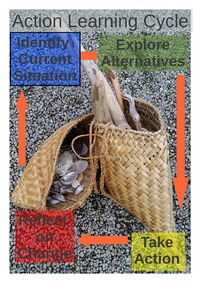Action learning cycle
From WikiEducator
Contents
Action Learning
- Is a tool used to help plan and undertake student-led environmental projects
- It empowers students to investigate, explore ideas, make decisions, take action and reflect on the changes they have created
Effective Environmental Education
- Observes and honours what is local
- Incorporates a variety of learning and teaching methods
- Can use digital, and must use non-digital tools
- Integrates throughout the curriculum
Learning log/s
- Plain piece of paper, book or digital device
- Space for images, events, quotes, sounds, ideas, interviews etc
- Prompts such as...
- I was surprised that
- I really enjoyed it how
- I felt that the
- I liked learning
Brainstorming
- Key words, spiders, mind maps, free sketch etc
- Reflection - why?
- Pooling knowledge, sharing our thoughts etc
- Reflection - why?
Experiential learning
- Listen count/record nature versus humanity made sounds
- Rope tied in loop, group blindfolded, holding rope/wool everyone creates a shape - square etc
- Cloud spotting - types if known, direction, shapes etc
- Reflection - why?
- Here and now, observational, leadership, team, environmental, secure, informed decisions, imagination
- Reflection - why?
Mapping
- Mental maps of area/surroundings - blank paper/screen
- Sound/colour maps
- Student in centre, records direction of sounds/colours
- Walk through area record on map sounds/colours
- Overlay maps
- Scale maps - big maps of small places
- Sculptured maps
Pool of Knowledge
- Is a visual display tool which shows the development of ideas and understandings
- Records responses and understandings
- Assists students to retain control of their own learning
- Facilitates collective learning
- Is a participatory way of building a picture
- Allows critical evaluation of values and actions
Local stories
- Traditional, fiction, legends etc
- A way to explore cultural knowledge
- Provide an opportunity to understand many aspects of historical life
Reflective Techniques
- Whole group/class polite shout out of one worders describing the experience/immersion
- Students choose a word from the list that most represents
- Something important about the experience
- Their best experience
- What they wished it had been like
- Their part in the activity
- What the group was like
- Their hopes for the next activity, etc, etc
- Wikimedia Creative Commons - picture of the day
- Group Collage
- A picture containing a picture/message
- Any materials or images collected
- Individuals explain reason for selection
